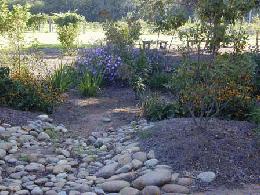Source(s): Wayne A Gardner, College of Agricultural and Environmental Sciences, Professor – Entomology Department
A rain garden was recently added to the theme gardens in the Demonstration Area of the Research and Education Garden on the UGA Griffin Campus. This new theme garden shows homeowners and professional landscapers how to design and manage a rain garden.
Rain gardens are designed to capture and absorb stormwater run-off from landscape surfaces. Most of these surfaces are hard and impervious to water, such as sidewalks, driveways, and building roofs.
These gardens may be large, complex bioretention-gardens that collect stormwater from mall roofs and parking lots. This garden is an example of a smaller, home landscape garden that is designed to handle stormwater run-off from the home landscape, roof, and driveway.
Why try to capture and absorb stormwater? Rain gardens help reduce water pollution. Studies have found that 70% of the particulates and other pollution in our streams, rivers and lakes are carried there by stormwater. Incredibly, about half of the pollutants in stormwater are from landscaping and gardening activities like cultivating, fertilizing, pruning, clipping, and applying pesticides.
By capturing stormwater runoff, rain gardens also allow this water to be absorbed into the ground and to return to the water table by natural percolation.
The Rain Garden in the Research and Education Garden also serves as a research area for Rose Mary Seymour of UGA’s Biological and Agricultural Engineering Department. Seymour is collecting data on amounts of water captured by this rain garden following rainfall.
Tony Johnson, horticulturist for the Research and Education Garden, designed and coordinated the installation of the garden. Johnson learned that plant selection is critical to the success of rain gardens. We ask a lot of plants in a rain garden. They must be able to survive flooding for 48 hours, and they must tolerate prolonged periods of dry weather, even drought.
Johnson has already identified several plants that meet these challenges while adding to the beauty of the home landscape. He suggests the following as excellent prospects for rain gardens in Georgia and the Southeast:
American smoke tree, Cotinus obovatus
Joe Pye weed, Eupatorium purpureum
Black-eyed Susan, Rudbeckia fulgida ‘Goldstrum’
Serviceberry, Amelanchier x grandiflora
Chokeberry, Aronia arbutifolia ‘Brilliantissima’
Daylily, Hemerocallis spp.
Louisiana iris, Iris spp.
Swamp hibiscus, Hibiscus coccineus
Clethera, Clethera alnifolia ‘Ruby Spice’ & Clethera alnifolia ‘Sixteen Candles’
Mexican petunia, Ruellia brittonia
Purple coneflower, Echinacea purpurea
Oak leaf hydrangea, Hydrangea quercifolia
If you are homeowner or professional landscaper interested in installing a rain garden, you should visit the Rain Garden at the Research and Education Garden. It combines natural shapes and features with beauty to create an environmentally friendly garden. For more information on rain gardens, click on the links below to view Rose Mary Seymour’s, “Why Create A Rain Garden in Our Landscape?” and “How to Build a Rain Garden”
Resource(s):
- Rain Gardens - September 23, 2013

